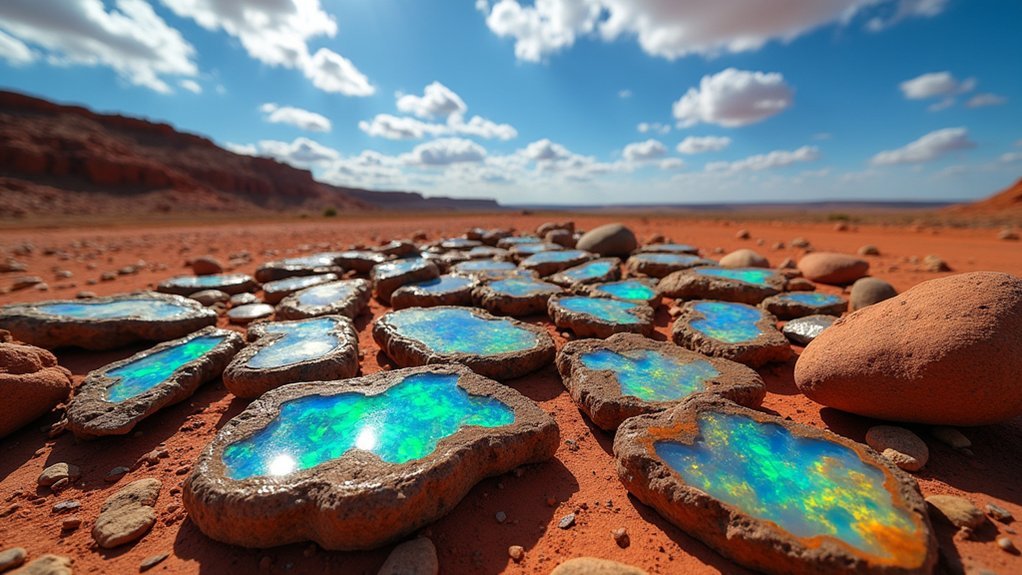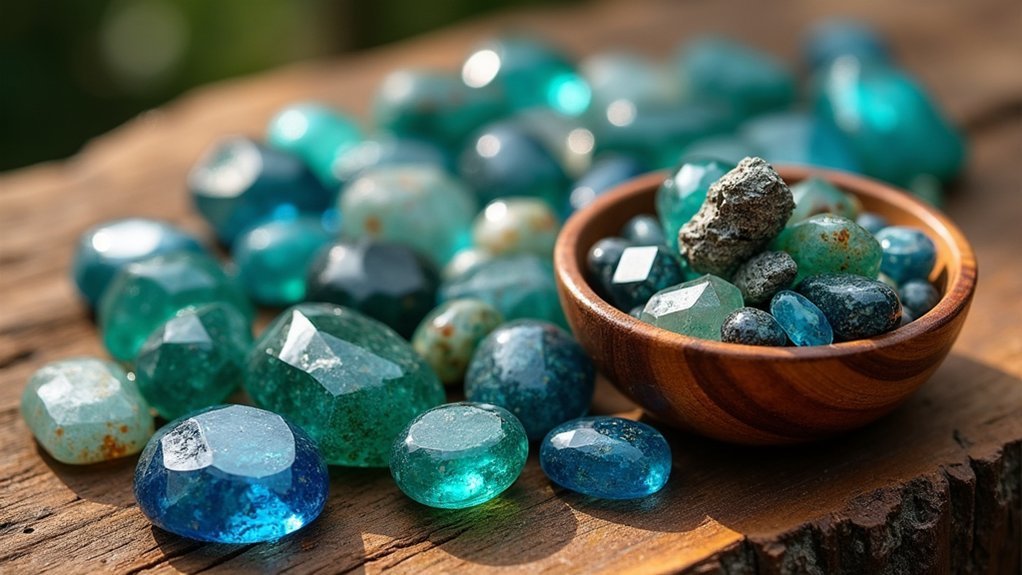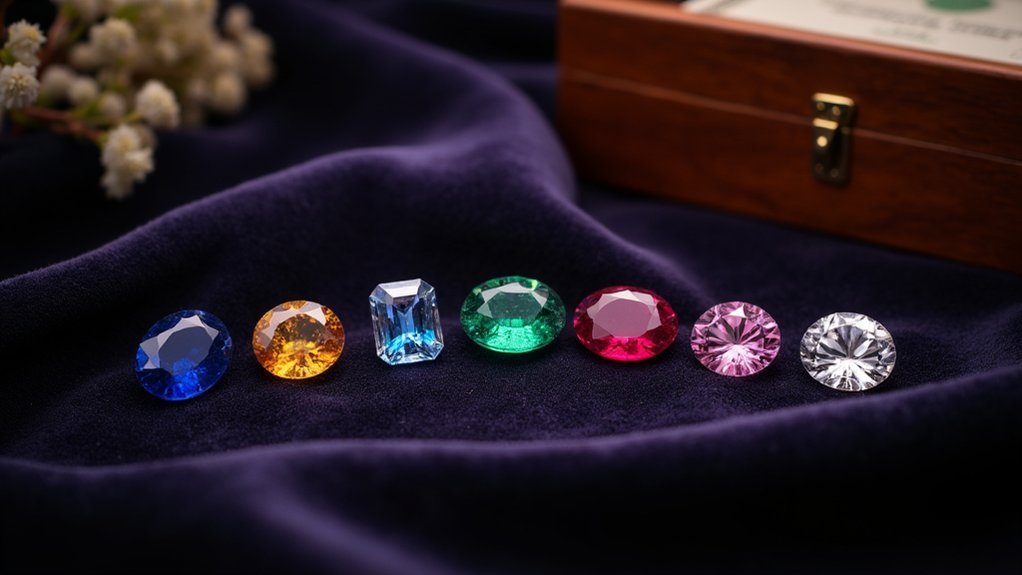You should prioritize Australian boulder opals and Canadian ammolite for their rigorous environmental standards and post-mining restoration requirements. Finnish spectrolite offers transparent Nordic mining operations, while Thai yellow and orange sapphires support regulated artisanal communities. Tanzanian cooperative gemstones empower small-scale miners through fair compensation, and Sri Lankan fair trade garnets provide community-based ownership models. Greenlandic indigenous ruby sources respect ancestral mining rights and cultural integrity. These seven sources demonstrate how responsible sourcing can transform your jewelry business while supporting ethical practices worldwide.
Australian Boulder Opals: Mining Excellence in the Outback

When you’re searching for ethically sourced gemstones, Australian Boulder Opals stand out as a premier example of responsible mining practices.
Queensland’s strict regulations guarantee minimal environmental impact while prohibiting toxic chemicals during extraction. You’ll find that skilled miners commit to thorough land rehabilitation after mining operations, restoring natural landscapes to their original state.
These vibrant, uniquely patterned gemstones support local communities through job creation and community development initiatives.
The ethical mining approach demonstrates Australia’s commitment to sustainable extraction methods that balance commercial success with environmental stewardship.
When you choose Boulder Opals for your jewelry business, you’re supporting responsible practices that protect ecosystems while providing economic benefits to Queensland communities.
This ethical sourcing model sets the standard for sustainable gemstone mining worldwide.
Canadian Ammolite: Responsible Extraction From the Rocky Mountains
You’ll find Canadian ammolite exclusively in Alberta’s Rocky Mountains, where it’s sourced from ancient ammonite fossils that create this rare gemstone.
The mining operations don’t use toxic chemicals and follow strict environmental standards that require complete land restoration after extraction.
This responsible approach guarantees you’re supporting sustainable practices while accessing one of the world’s most unique and ethically-sourced gemstones.
Exclusive Rocky Mountain Origins
Deep within Alberta’s Rocky Mountains lies one of the world’s most ethically sourced gemstones—Canadian Ammolite, harvested exclusively from ancient fossilized ammonite shells that have rested beneath these peaks for millions of years.
You’ll find this remarkable gemstone nowhere else on Earth, making it truly unique in the ethical gemstones market.
When you choose Ammolite, you’re supporting mining practices that prioritize environmental responsibility. The extraction process doesn’t rely on toxic chemicals, setting it apart from traditional mining operations.
Local communities directly benefit through job creation and income generation while preserving their cultural heritage.
These responsible sourcing methods guarantee minimal environmental impact, with strict regulations requiring land rehabilitation after extraction.
You’re getting vibrant colors and unique patterns while supporting environmentally conscious practices.
Post-Mining Land Restoration
After ammolite extraction concludes, mining companies don’t simply abandon the sites—they’re legally obligated to restore the land to its original ecological state.
This post-mining land restoration process guarantees minimal environmental impact while supporting ecosystem recovery. You’ll find that rehabilitating landscapes involves replanting native vegetation, rebuilding soil composition, and creating habitats that welcome back local wildlife.
These sustainable practices align perfectly with ethical gemstone sourcing principles that conscious jewelers prioritize. Companies systematically monitor restoration progress, tracking biodiversity levels and habitat development over years.
Rather than causing long-term environmental harm, ammolite mining operations actually contribute to enhanced land management. When you choose Canadian ammolite, you’re supporting an industry that takes responsibility for its environmental footprint and actively works to preserve Rocky Mountain ecosystems.
Responsible Extraction Practices
While many gemstone extraction methods rely on harmful chemicals and destructive techniques, Canadian ammolite mining stands apart through its commitment to clean, responsible practices.
You’ll find that this ethical gemstone mining approach prioritizes both environmental protection and community welfare throughout the Rocky Mountains region.
Here’s what makes Canadian ammolite extraction truly responsible mining:
- Chemical-free extraction processes that eliminate toxic substances, protecting miners and surrounding ecosystems from contamination.
- Environmentally friendly operations that minimize ecological impact through strict regulatory compliance and sustainable practices.
- Community engagement initiatives that guarantee local populations receive fair wages and economic benefits from mining activities.
- Long-term commitment to supporting local economies through stable employment opportunities and sustainable livelihoods.
These practices demonstrate how responsible extraction can benefit everyone involved.
Finnish Spectrolite: Transparent Operations in Nordic Mines
When you’re sourcing Finnish Spectrolite, you’ll encounter Nordic mining standards that set the global benchmark for ethical extraction practices.
You can actually visit these transparent operations, as Finland’s mines welcome public access to showcase their responsible methods firsthand.
These open-door policies don’t just build trust—they create valuable tourism opportunities that benefit local communities while supporting your commitment to ethical sourcing.
Nordic Mining Standards
As you explore ethical gemstone sourcing, Finnish spectrolite mining stands as a gold standard for transparent operations that prioritize both environmental stewardship and community engagement.
When you’re evaluating gemstones for your jewelry business, Finland’s extensive mining standards demonstrate how the industry can operate responsibly while producing exceptional quality stones.
Nordic mining standards encompass four critical elements that set Finnish spectrolite apart:
- Environmental Protection – Strict regulations minimize ecological impact during extraction
- Worker Safety – Extensive safety protocols protect all personnel
- Non-toxic Methods – Chemical-free extraction processes avoid harmful substances
- Land Rehabilitation – Post-mining restoration practices return sites to natural habitats
You’ll find that Finnish operations maintain open access policies, allowing public oversight and supporting local tourism while ensuring transparency throughout the entire sourcing chain.
Public Mine Access
Finland’s spectrolite mines offer something unprecedented in the gemstone industry: complete public access that transforms mining from a secretive operation into an educational experience.
You’ll witness ethical mining practices firsthand, observing how companies minimize environmental impact through sustainable operations and mandatory land rehabilitation. These transparent facilities demonstrate strict labor laws ensuring fair treatment of workers while supporting local tourism and job creation in surrounding communities.
When you visit these open mining sites, you’re seeing accountability in action. The public access model proves that gemstone extraction doesn’t require secrecy or environmental destruction.
You’ll understand why spectrolite represents the gold standard for ethical sourcing, as these mines operate under Finland’s rigorous regulations that prioritize both worker welfare and ecological responsibility throughout their operations.
Local Tourism Benefits
This transparency creates a powerful economic engine that extends far beyond the mining operations themselves.
Finnish spectrolite mining demonstrates how addressing ethical issues through openness can transform small-scale mining operations into tourism magnets. You’ll find that this transparency approach resolves environmental impact concerns while creating sustainable practices that benefit local tourism.
The gemstone industry rarely sees such extensive community engagement:
- Tourist Revenue Growth – Communities involved earn significant income from gemstone enthusiasts and eco-conscious travelers visiting ethical mining sites.
- Educational Tourism – Visitors learn about responsible sourcing while experiencing authentic Nordic mining culture.
- Small Business Support – Local accommodations, restaurants, and guide services thrive from increased visitor traffic.
- Land Rehabilitation Showcase – Well-regulated sites become examples of environmental stewardship, attracting sustainability-focused tourists.
Thai Yellow and Orange Sapphires: Regulated Mining Practices
When you’re sourcing yellow and orange sapphires, Thailand stands out as a prime example of how traditional mining can align with modern ethical standards.
Thai yellow and orange sapphires come from small-scale artisanal mining operations that use traditional methods minimizing environmental impact. The country’s regulated mining practices guarantee compliance with strict labor laws and environmental standards, creating safer working conditions for miners.
Thailand’s artisanal sapphire mining combines centuries-old techniques with modern ethical standards, ensuring environmental protection and fair labor practices.
You’ll find Thailand produces some of the world’s highest quality sapphires, renowned for their vibrant colors and exceptional clarity.
This artisanal mining directly supports local economies, providing essential livelihoods to rural families. The Thai government’s monitoring policies enhance traceability throughout the sapphire trade, making ethical sourcing straightforward for jewelers seeking responsibly mined gemstones.
Tanzanian Cooperative Gemstones: Supporting Small-Scale Miners

How can you guarantee your gemstone purchases directly benefit the miners who extract them from the earth? Tanzanian cooperative gemstones offer a powerful solution through organizations like the Tanzanian Women Miners Association (TAWOMA).
These cooperatives champion fair trade practices while empowering small-scale miners who extract approximately 70% of Tanzania’s gemstones.
When you choose Tanzanian cooperative gemstones, you’re supporting:
- Environmentally responsible mining practices that prioritize land rehabilitation and sustainable gemstone sourcing
- Community development initiatives funding education, healthcare, and infrastructure for miners’ families
- Transparent supply chain systems that verify ethical sourcing practices
- Economic empowerment of artisanal miners through better market access and fair compensation
This cooperative model transforms traditional mining by creating lasting positive impact for both miners and their communities.
Sri Lankan Fair Trade Garnets: Community-Based Mining Models
Sri Lanka’s garnet mining industry showcases another exemplary model of ethical gemstone sourcing through community-based cooperatives that put miners at the center of decision-making and profit-sharing. These small-scale operations prioritize fair trade principles while maintaining Sri Lanka’s reputation for producing exceptional garnets, including the coveted deep red hessonite variety.
| Aspect | Community-Based Benefits |
|---|---|
| Mining Structure | Cooperative ownership with shared resources |
| Worker Compensation | Fair wages through profit-sharing systems |
| Safety Standards | Safe working conditions for artisanal miners |
| Environmental Impact | Land rehabilitation and sustainable practices |
| Certification | Fair Trade Gemstone Certification compliance |
You’ll find that community-based mining enhances economic stability while ensuring environmental sustainability. These ethical practices make Sri Lankan garnets an ideal choice for jewelers committed to responsible sourcing without compromising quality.
Greenlandic Indigenous Ruby Sources: Ancestral Land Mining Rights

Although Greenland’s ruby mining industry is relatively new to international markets, Indigenous Inuit communities have maintained deep cultural connections to these gemstones for centuries, transforming ancestral gathering practices into legitimate commercial operations that honor both tradition and modern ethical sourcing standards.
You’ll find Greenlandic rubies offer unique advantages for ethical jewelers:
- Recognized Mining Rights – Late 2018 brought international trading permissions, legitimizing Indigenous ownership
- Cultural Integrity – Traditional practices remain central to extraction methods
- Sustainable Operations – Community-based approaches minimize environmental impact
- Economic Empowerment – Direct support strengthens local economies
The Fair Jewelry Action organization actively champions these Indigenous mining rights.
When you source Greenlandic rubies, you’re accessing distinctive colors and quality while supporting communities who’ve stewarded these ancestral lands responsibly for generations.
Frequently Asked Questions
What Are the Ethical Issues With Gemstones?
You’ll face child labor concerns, environmental damage from mining operations, worker exploitation in unsafe conditions, and supply chain opacity that enables conflict funding and unethical practices throughout gemstone sourcing.
Are Lab Grown Gemstones More Ethical?
You’ll find lab-grown gemstones considerably more ethical since they eliminate mining’s environmental damage, reduce water and energy consumption, guarantee transparent sourcing, and avoid potential human rights violations associated with traditional extraction.
Is Sapphire Ethically Sourced?
You’ll find sapphires can be ethically sourced from regions like Sri Lanka, Australia, and Madagascar. Look for Fair Trade certifications or consider lab-grown alternatives that guarantee conflict-free origins.
Is Moss Agate Ethical?
You’ll find moss agate’s ethics depend on specific mining practices. Since there aren’t standardized certifications, you should research vendors who provide detailed sourcing information and support fair labor practices.
In Summary
You’ve discovered seven exceptional sources that prove ethical gemstone sourcing isn’t just possible—it’s profitable. By choosing suppliers from Australia’s regulated opal mines, Canada’s responsible ammolite operations, and Finland’s transparent spectrolite facilities, you’re building trust with conscious consumers. Don’t overlook Thailand’s regulated sapphire industry, Tanzania’s mining cooperatives, Sri Lanka’s fair trade garnets, and Greenland’s indigenous ruby sources. These partnerships will differentiate your business while supporting sustainable practices worldwide.





Leave a Reply